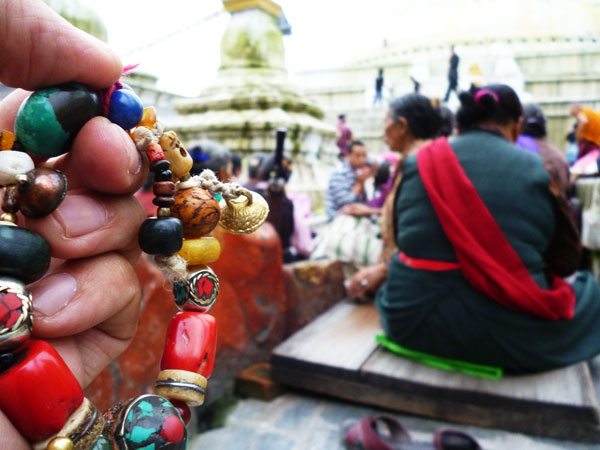 For millennia , the rural cultures of Tibet, Nepal , Bhutan and Mongolia, have worn the bracelets Theng ngnà , these amulets have for each element a correct interpretation of mystical meanings . They are symbols of respect and veneration, which are used by the monks, shamans, animists rural people and nomadic tribes in remote regions of the Himalayas. According to careful scholars of ancient Tibetan iconography as Nebesky – Wojkowitz, writers on the origin of the ancestral deities, knowledge of these amulets are transmitted orally in the Nordic region of Amdo, in Thang-Lha (Byang Thang) at the foot of the Sacred Mountain Yar – Lha – Sham – Po, there is little information available outside of this context, there are not names and dates specified in Tibetan mythology. Many details have disappeared over time, this makes us see how the popular landmark is the only witness, the rites and traditions concerning the gods of the four mountains. It is said that God Yar – Lha – Sham – Po (pre-Buddhist deities for the nomadic tribes of the Yar and the rest of the Tibetan population), had given a wise healer Bon-po, the task of creating a powerful talisman that contained elements of light, sacred stones of the mountain, three metals, “Dzi” the jewel fell from the sky, plants with many beneficial properties, and containing the three main colors merged into white light. The amulet was to be able to give from the heart of the people, the celestial energy and spiritual virtues. Blue Lapis= Will, Yellow Amber= Wisdom, Red coral=Action. For the Himalayan population the metals and stones have different characteristics with regard to the irradiation of energy. According to the myth, the God Yar-Lha-Sham Po, has extraordinary magical powers, rides a white yak. From the mouth and nostrils of the mighty animal out lightning and thunder that give rise to snow avalanches. This deity of the mountain can destroy the big rocks of the cliffs, it turns into a white man who arouse sensual passion of women and girls of the villages and regions. In the Tibetan historiology God Yar-Lha-Sham Po is called the noble gods, and represents the power of the royal family. Before Buddhism, members of the nobility worshiped the deities of Bon; these families ancestors were using stones, symbols and amulets protectors Theng Ngnà. For a long time they remained faithful to these particular amulets that also possessed a secret ingredient. In Tibetan mythology the divine images of amulets are identified with religious elements, rather than on the same mountain (considered deities). The gods of the Tibetan pantheon are imbued with the energy of the animist and Buddhist mysticism, represented in rocks, animals, ancestors, paintings, symbols and amulets.
For millennia , the rural cultures of Tibet, Nepal , Bhutan and Mongolia, have worn the bracelets Theng ngnà , these amulets have for each element a correct interpretation of mystical meanings . They are symbols of respect and veneration, which are used by the monks, shamans, animists rural people and nomadic tribes in remote regions of the Himalayas. According to careful scholars of ancient Tibetan iconography as Nebesky – Wojkowitz, writers on the origin of the ancestral deities, knowledge of these amulets are transmitted orally in the Nordic region of Amdo, in Thang-Lha (Byang Thang) at the foot of the Sacred Mountain Yar – Lha – Sham – Po, there is little information available outside of this context, there are not names and dates specified in Tibetan mythology. Many details have disappeared over time, this makes us see how the popular landmark is the only witness, the rites and traditions concerning the gods of the four mountains. It is said that God Yar – Lha – Sham – Po (pre-Buddhist deities for the nomadic tribes of the Yar and the rest of the Tibetan population), had given a wise healer Bon-po, the task of creating a powerful talisman that contained elements of light, sacred stones of the mountain, three metals, “Dzi” the jewel fell from the sky, plants with many beneficial properties, and containing the three main colors merged into white light. The amulet was to be able to give from the heart of the people, the celestial energy and spiritual virtues. Blue Lapis= Will, Yellow Amber= Wisdom, Red coral=Action. For the Himalayan population the metals and stones have different characteristics with regard to the irradiation of energy. According to the myth, the God Yar-Lha-Sham Po, has extraordinary magical powers, rides a white yak. From the mouth and nostrils of the mighty animal out lightning and thunder that give rise to snow avalanches. This deity of the mountain can destroy the big rocks of the cliffs, it turns into a white man who arouse sensual passion of women and girls of the villages and regions. In the Tibetan historiology God Yar-Lha-Sham Po is called the noble gods, and represents the power of the royal family. Before Buddhism, members of the nobility worshiped the deities of Bon; these families ancestors were using stones, symbols and amulets protectors Theng Ngnà. For a long time they remained faithful to these particular amulets that also possessed a secret ingredient. In Tibetan mythology the divine images of amulets are identified with religious elements, rather than on the same mountain (considered deities). The gods of the Tibetan pantheon are imbued with the energy of the animist and Buddhist mysticism, represented in rocks, animals, ancestors, paintings, symbols and amulets.
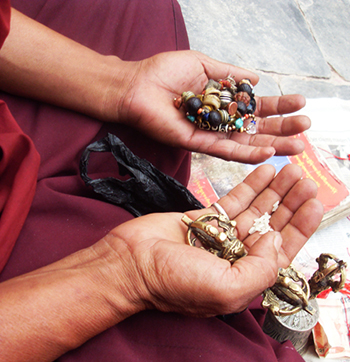 Consecration of the amulet
Consecration of the amulet




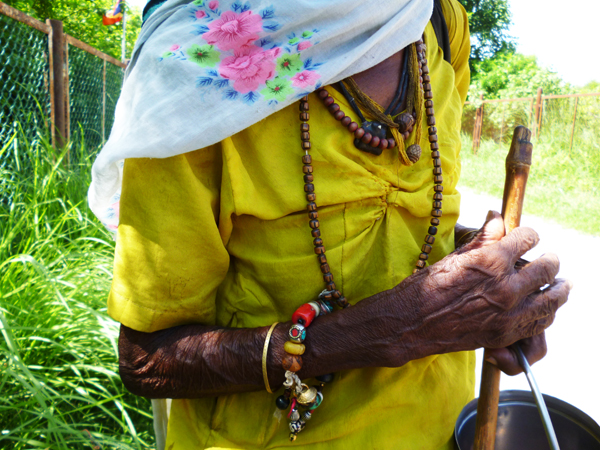 Ancient sacred texts such as the Sutra of Omnipresence refer to “five poisonous eyes of evil,” bad thoughts and traps of jealousy. He asserts that “the strategy of ‘ eye for an eye” revenge, would be the cause that would create bad karma . It is believed that objects such as agate Dzi beads , necklaces made of turquoise , coral, amber etc . adorned the most important and revered statues. Cosmology and Buddhist teachings on ‘ soul explain that it is the substance of the human spiritual , higher , eternal and unchanging , identical to the “I” . The ‘ soul decreed the act of nature , the same nature and its elements provide strength and protection. Shamans Himalayan state that nature has a conscience and their own business , and energy forms in the universe . The components of Theng ngna ‘ are unintelligent and can not have their own will , therefore , there must be a cause them awakenings , making them active , making trigger the potential inherent in each stone or metal. The act of this cause is the ‘ intention of those who gave shape, the sound vibration of his prayers in the ‘ geographical environment . The cause that gives rise to the energy of ‘ object relates to the interaction between soul and nature, creator of the object and the wearer . With its symbolism , an amulet reminds us of the way we want to follow , what we want to happen in our lives, encourages us to persevere in achieving our goal. Wear it causes us to be constantly aware of it, to stay focused . Giving attention to strive for their goals and means to achieve them. And ‘ necessary to specify that the amulets have the importance that each person gives , if you do not internalize their deep meaning in relation to his own being , it is best not to wear it . In other places of the ‘ Central Asia, Brahmins , Buddhists and Hindus believe that owning these special talismans attract positive energies and amplify the good that already exists. Passed down from generation to generation as a valuable cultural and spiritual heritage of the Theng Ngna ‘ amulets are handmade, unique and personal aimed at preserving its holders from danger , pain, wickedness and risks caused by evil spirits. According to the religious preceptors of the ancient art related to the protection invisible , are a symbol for good luck that protects its owner from disease and other dark forces considered dangerous . For a long time the information about the fascinating objects have remained a privilege of the few wise and knowledgeable of the practices related to ritualiche Bon , the ancestral doctrine that converged with other methods and hidden mystical knowledge in the areas of Qinghai, the historic land of Amdo .
Ancient sacred texts such as the Sutra of Omnipresence refer to “five poisonous eyes of evil,” bad thoughts and traps of jealousy. He asserts that “the strategy of ‘ eye for an eye” revenge, would be the cause that would create bad karma . It is believed that objects such as agate Dzi beads , necklaces made of turquoise , coral, amber etc . adorned the most important and revered statues. Cosmology and Buddhist teachings on ‘ soul explain that it is the substance of the human spiritual , higher , eternal and unchanging , identical to the “I” . The ‘ soul decreed the act of nature , the same nature and its elements provide strength and protection. Shamans Himalayan state that nature has a conscience and their own business , and energy forms in the universe . The components of Theng ngna ‘ are unintelligent and can not have their own will , therefore , there must be a cause them awakenings , making them active , making trigger the potential inherent in each stone or metal. The act of this cause is the ‘ intention of those who gave shape, the sound vibration of his prayers in the ‘ geographical environment . The cause that gives rise to the energy of ‘ object relates to the interaction between soul and nature, creator of the object and the wearer . With its symbolism , an amulet reminds us of the way we want to follow , what we want to happen in our lives, encourages us to persevere in achieving our goal. Wear it causes us to be constantly aware of it, to stay focused . Giving attention to strive for their goals and means to achieve them. And ‘ necessary to specify that the amulets have the importance that each person gives , if you do not internalize their deep meaning in relation to his own being , it is best not to wear it . In other places of the ‘ Central Asia, Brahmins , Buddhists and Hindus believe that owning these special talismans attract positive energies and amplify the good that already exists. Passed down from generation to generation as a valuable cultural and spiritual heritage of the Theng Ngna ‘ amulets are handmade, unique and personal aimed at preserving its holders from danger , pain, wickedness and risks caused by evil spirits. According to the religious preceptors of the ancient art related to the protection invisible , are a symbol for good luck that protects its owner from disease and other dark forces considered dangerous . For a long time the information about the fascinating objects have remained a privilege of the few wise and knowledgeable of the practices related to ritualiche Bon , the ancestral doctrine that converged with other methods and hidden mystical knowledge in the areas of Qinghai, the historic land of Amdo .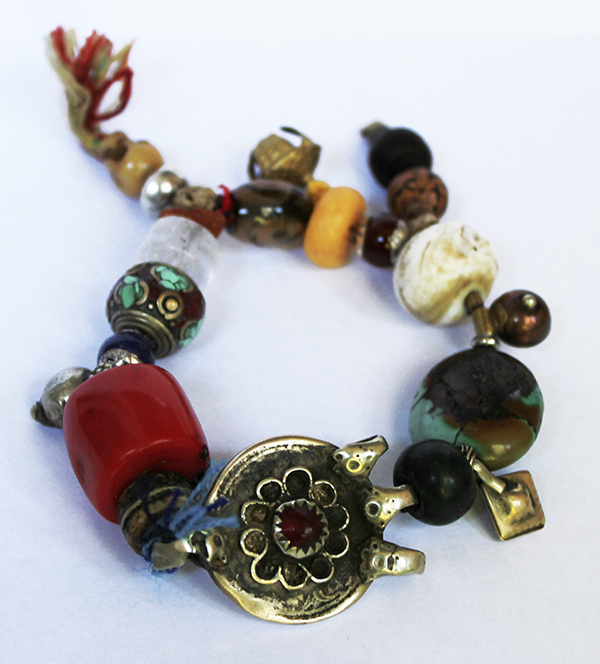
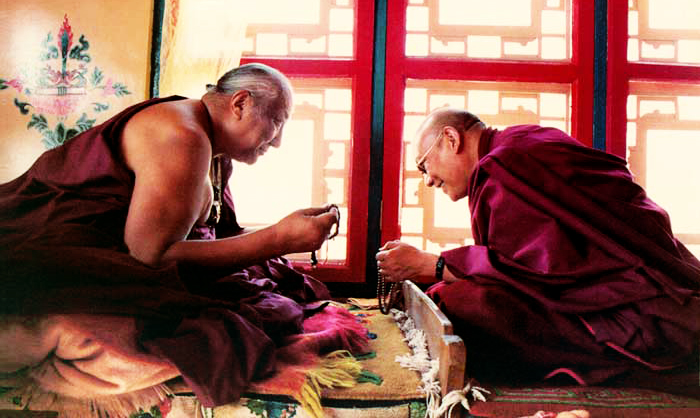 Khyense Dilgo Rinpoche (teacher of the XIV Dalai Lama) was an admirer of rare and ancient objects related to the spiritual quest, he was 12 years study and meditation in a secluded cave in the mountains of Tibet. Always wore amulets during its existence, together with Dzi Beads, Gau, bracelets and other relics dating back to the time of the historical Buddha and other masters believers. Gyalse Trulke from Satsam Chorten (in Paro, Bhutan) argues that the amulets such as tanka, mandalas and symbolic representations made by men and women of strong faith, help to illuminate living beings, they are perceived through our five senses of light and are able to liberate and protect the people. Today the Theng Ngna ‘are almost unknown to the Tibetans themselves. Their true meaning has been destroyed by the many sufferings inflicted on the people by the violent imposed by the Chinese government. Along with ancient ceremonies and rituals otherworldly these legendary amulets try to survive the insidious western modernism, die in their tracks. Hide their appearance in the definitions of the various languages, dialects and mysteries that co-exist in the rugged and majestic himalayan geography; Theng Ngna, Ga’u, Chos skyong sgrog gdung, Lackpa taya, Norbu dzi or Thog chags, are some of the many names. In 1959, after the communist invasion, the Dalai Lama fled from Tibet. The elderly Lama and officials who accompanied him in exile took with their jewelry very valuable. Coral, lapis lazuli, turquoise and amber formed, along with ritual objects, the different bracelets used as amulets. Some monks brought the mysterious stones of agate Dzi.
Khyense Dilgo Rinpoche (teacher of the XIV Dalai Lama) was an admirer of rare and ancient objects related to the spiritual quest, he was 12 years study and meditation in a secluded cave in the mountains of Tibet. Always wore amulets during its existence, together with Dzi Beads, Gau, bracelets and other relics dating back to the time of the historical Buddha and other masters believers. Gyalse Trulke from Satsam Chorten (in Paro, Bhutan) argues that the amulets such as tanka, mandalas and symbolic representations made by men and women of strong faith, help to illuminate living beings, they are perceived through our five senses of light and are able to liberate and protect the people. Today the Theng Ngna ‘are almost unknown to the Tibetans themselves. Their true meaning has been destroyed by the many sufferings inflicted on the people by the violent imposed by the Chinese government. Along with ancient ceremonies and rituals otherworldly these legendary amulets try to survive the insidious western modernism, die in their tracks. Hide their appearance in the definitions of the various languages, dialects and mysteries that co-exist in the rugged and majestic himalayan geography; Theng Ngna, Ga’u, Chos skyong sgrog gdung, Lackpa taya, Norbu dzi or Thog chags, are some of the many names. In 1959, after the communist invasion, the Dalai Lama fled from Tibet. The elderly Lama and officials who accompanied him in exile took with their jewelry very valuable. Coral, lapis lazuli, turquoise and amber formed, along with ritual objects, the different bracelets used as amulets. Some monks brought the mysterious stones of agate Dzi.
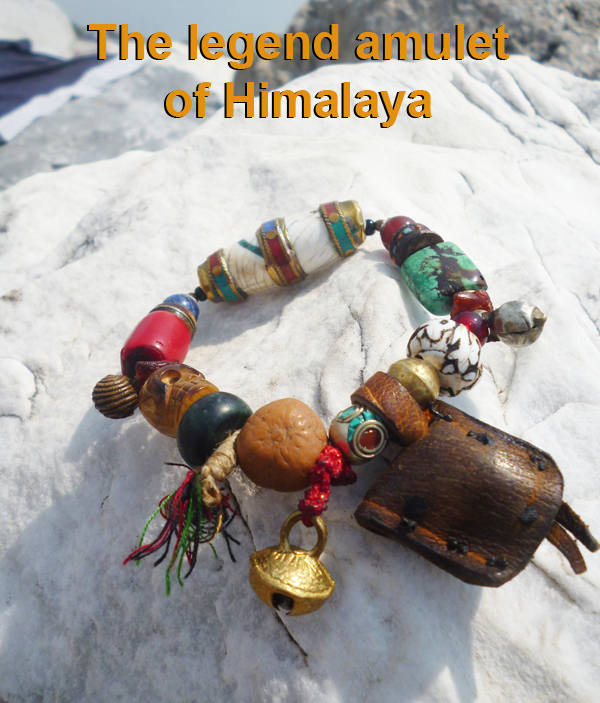 Into The shape of amulets tutelary varies according to the creators and their places of origin. Highly sought are those made by artisans and shamans of Bhutan, Tibet, Qinghai and the area of Mustang. The legends of ancient peoples are not sufficient to meet the obsession of archaeologists, anthropologists and western scholars who have long been working to find out how much truth is there in this story and how it has originated this myth handed down from generation to generation during many centuries. The classics of Hung-Chang Shih support the theory of the treasure of the Persian King brought home from the Tibetan warriors who won an impressive series of wars. Popular belief has mythologized the wonderful artifacts, people in rural villages manifested through faith their sacred meaning. The latent energy of its parts united and bright colors by carrying away, the vigor and vitality of those who through inner conviction, relying on a small amulet their safety in difficult territories, governed by the elements, places where human survival is put to the test.
Into The shape of amulets tutelary varies according to the creators and their places of origin. Highly sought are those made by artisans and shamans of Bhutan, Tibet, Qinghai and the area of Mustang. The legends of ancient peoples are not sufficient to meet the obsession of archaeologists, anthropologists and western scholars who have long been working to find out how much truth is there in this story and how it has originated this myth handed down from generation to generation during many centuries. The classics of Hung-Chang Shih support the theory of the treasure of the Persian King brought home from the Tibetan warriors who won an impressive series of wars. Popular belief has mythologized the wonderful artifacts, people in rural villages manifested through faith their sacred meaning. The latent energy of its parts united and bright colors by carrying away, the vigor and vitality of those who through inner conviction, relying on a small amulet their safety in difficult territories, governed by the elements, places where human survival is put to the test.
Recent Comments